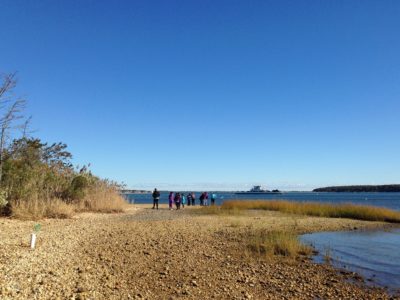Blog
Widow’s Hole Preserve Update: Spring Restoration
By Matt Swain, Yvette DeBow-Salsedo
It’s been a little while since we’ve given you an update of what’s happening with the restoration efforts at Widow’s Hole Preserve. In 2019, expect to see many changes to the landscape as the restoration begins in earnest!
Over the past several years, our stewardship team has been developing the long-term management plan for the preserve. This work has taken place in conjunction with Cornell Cooperative Extension of Suffolk County’s Marine program – which has provided expertise on marine habitat restoration. The plan was completed last year, a necessary first step before submitting permit requests to the various government agencies that provide oversight for land and wetland restoration: the NYS Department of Environmental Conservation, the US Army Corps of Engineers and the Village of Greenport.
Important to note: While the Town of Southold holds the easement on the property – and has provided approvals for our work – the DEC, Army Corps and Village are the entities who provide the permits for the actual work at the Preserve.
![block.image[0].title](/assets/images/IMG_2385.JPG)
We are pleased to report that most of the paperwork is behind us, although we do still have before the Village of Greenport’s Zoning Board of Appeal permit applications for new signage at the site, which will include a kiosk to provide information on the history of the site and the restoration. We are hopeful that those permits will be in place by spring.
In the meantime, we are acquiring the raw materials needed — the sand, gravel, cobblestones and rock — needed for the upland and wetland restoration. The delivery and placement of the materials is expected to occur from March-April.
After the sand has been graded in April, Cornell plans to work with community volunteers to plant American beachgrass along the upper beach and newly created dune for stabilization. Beachgrass plants have been growing at the Trust’s Agricultural Center in Southold for the last two seasons in preparation for revegetating the project site.
Spartina, commonly known as cordgrass or cord-grass, is a grass found in coastal salt marshes. The grass is a native plant and has been naturally growing in the wetlands surrounding the Preserve.
What we have done is harvest some of naturally growing Spartina seeds from area salt marshes, processed them, and stored them at Cedar Beach, where they will be planted out in the greenhouse in March. The greenhouse-grown plants will be maintained until planted out starting in June.
Also, Spartina plants that were growing in the project area at Widow’s Hole were transferred from the preserve to Cornell’s facility at Cedar Beach where they were “heeled-in” for the winter. This process will multiply and strengthen the plants, which will then be replanted as part of the restoration process.
![block.image[0].title](/assets/images/IMG_2391.JPG)
Plans are also afoot for the replacement of the fence. The new fencing will open up the vista to the community, while protecting the sensitive nature of the preserve.
And last, but certainly not least, we are continuing to remove invasive plants, shrubs and trees from the Preserve, including autumn olive, Japanese honeysuckle, Asian bittersweet, mile-a-minute vine. Also a number of non-native trees. The removal of invasive plants is important for the overall health of the Preserve as their growth tends to be out of balance with the native plants.
Our thanks go out to the Peconic Estuary Program for their funding support of this project.
We look forward to sharing more news as the spring nears. If you have questions or concerns, please reach out to us!
Additionally, interested in volunteer to help with the beachgrass plantings this spring? Contact Senior Stewardship Manager Matt Swain or our Outreach Manager Kathy Kennedy.
![block.image[0].title](/assets/images/PLT-Ag-Center-Beachgrass-for-Widows-Hole.jpg)


